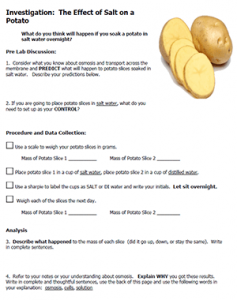
Students observe how the mass of a potato slice changes when soaked overnight in salt water. The activity is intended to be done as part of a lesson on osmosis and hypertonic and hypotonic solutions. Students will need about 15 minutes to set up their cups, weigh their slices and make predictions about what they think will happen.
This is an ideal activity to occur at the end direct instruction on osmosis (Google Slides) . Students then return the next day, or over a weekend, and weigh their slices again. The slices soaked in salt water should have lost weight due to osmosis (remind students that “salt sucks”). The ones soaked in distilled water will gain weight, because the cells of the potato have more solutes.
You will need enough scales to weigh the potatoes. I’ve slowly been acquiring scales from Amazon, which are much cheaper than those sold at biological supply companies. I have about 10 of them for a class size of 30, so there is still sharing necessary, which does increase the set-up time. DI water can be purchased from grocery stores.
I’ve experimented with different ways to slice the potato. If sliced in french fry shapes, students can actually feel the difference, the salty potatoes will be limp and the DI potatoes will still be crunchy. Another option is to use baby carrots instead of potatoes, reducing one step in the set-up process of the lab. You may also want to have students cover their cups with saran wrap, especially if you are leaving them to soak over the weekend.
You can also substitute baby carrots, which may reduce the prep time of slicing the potatoes.
There is another version of this lab that uses baby carrots. This eliminates the need to cut potatoes and the results are the same.
This lab was adapted from an AP Lab on Water Potential and Osmosis.
Grade Level: 8-10
Time Required: 15 minutes set-up (Day 1) , 15 minutes (Day 2)
HS-LS1-2 Develop and use a model to illustrate the hierarchical organization of interacting systems that provide specific functions within multicellular organisms

